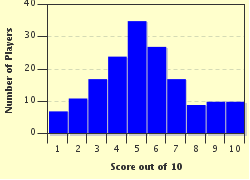Quiz Answer Key and Fun Facts
1. The history of code use in war goes back thousands of years. On of the earliest uses of codes was a simple substitution cipher that switched the first letter of the alphabet for the last, the second letter for the next to last, and so on. This ancient code was used by the Hebrew nation and is called what?
2. Known for his brilliant military prowess during the Gallic Wars, Julius Caesar encoded his messages using a cipher that substitued the desired letter for a letter several positions away. What was this cipher known as?
3. The ancient Greeks used codes as well, or rather, a bit of a puzzle. Lysander of Sparta was a Greek general, who in 405 BC, received a message on the person of his servant. What article of clothing bore a coded word puzzle that was deciphered to assist Lysander to conquer the Persians?
4. Although this sounds like something of legend, the Revolutionary War was aided by codes, everything from using ancient ciphers to employing an alpha-numeric code. However, it was Silas Deane's invention that aided in the safe delivery of code using which one of his inventions?
5. The Continental Congress not only used neat inventions, but special codes. One such code used a particular publication that required the message to be derived from a series of numbers that identified a particular page, line number, and word number to locate the message in plain text. Which book?
6. Coded messages were heavily used during the American Civil War by both the North and the South. One such code relied on a cypher made famous by a member of the British nobility, Archibald Campbell, which used an alpha-numeric cypher of number sets, plain-text words and various symbols. What was Campbell the Earl of?
7. One of the more famous ciphers was used by a fraternal organization that had its roots in the regulation of a specific type of craft guild. This cipher was sometimes called a "cell cipher" as each letter of the alphabet was assigned a certain position within a tick-tack-toe box and/or an "x-shape" with or without "dots." What is the name of this cipher?
8. By the time of World War I, coding and codebreaking had developed to a point where one needed to get creative with the types of codes used. Upon realization that he couldn't understand his men converse, a U.S. Army captain put one Native American language to use and "codetalkers" were born. Which Native American language was used during World War I?
9. World War II brought advancements in the codes of war with the invention of the Enigma machine. This device used a series of rotors and a keyboard, with adjustments made daily to continually change the encryption. Which country developed this device controlling the war until the device was captured and the code broken?
10. Messages have been delivered via Morse code for decades. However, during the Vietnam War, American prisoner-of-war, Jeremiah Denton, used Morse code in a most unusual way to convey a message regarding his treatment by the North Vietnamese. In what way did Denton convey his message?
Source: Author
TemptressToo
This quiz was reviewed by FunTrivia editor
bloomsby before going online.
Any errors found in FunTrivia content are routinely corrected through our feedback system.


